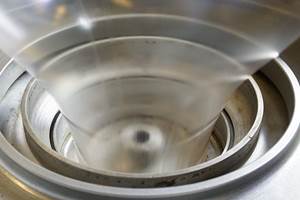A Family Film Business Goes High-Tech
Papa, as Norman Rabenstein is fondly called on the shop floor, brought his family up to make plastic film.
Papa, as Norman Rabenstein is fondly called on the shop floor, brought his family up to make plastic film. He founded Allied Extruders Inc. in Long Island City, N.Y., in 1969 to make packaging film and later garment bags. Since then, three generations of the family have been involved in film extrusion, and Allied’s capacity has grown to more than 50 million lb/yr of monolayer LDPE and LLDPE blown film. Much of that is short runs for small customers.
Allied built its mostly commodity 911±¬ÁĎÍř with simple and inexpensive extrusion equipment. But in the last few years it acquired two high-tech lines with greatly improved quality and productivity. That has spurred this family-run company to raise its level of technology across the board by buying more new lines and upgrading old ones. Its priority is to expand and upgrade its capacity and efficiency to capture more high-end 911±¬ÁĎÍř.
Investing in technology
As Allied grew, Rabenstein bought the factories and empty lots next door, stringing together four plants that now house 22 blown-film lines. This unplanned growth resulted in a somewhat inefficient manufacturing layout. So one of the firm’s challenges now is to rethink the manufacturing space. Allied plans to build a modern plant on a neighboring lot to hold up to eight film lines with up-to-date technology.
Twenty of Allied’s machines are basic Sano models as much as 30 years old. Some were bought used, but all have been extensively rebuilt with new barrels and screws. Several also received new drives, air rings, and bubble protectors.
Four years ago, in an effort to upgrade in order to service high-end converters, Allied bought a new sophisticated extrusion line from Davis-Standard’s Egan Div. in Somerville, N.J. With a 5.4-in. MAC extruder, 20-in. die, and 84-in. oscillating hauloff, it was Allied’s largest at the time. The collapsing frame has carbon-fiber rollers and two 84-in. turret winders that can make up to 40-in.-diam. rolls. This year, Allied added a second and even larger new Davis-Standard Egan line. It has a 6-in. extruder, 24-in. die, and 94-in. oscillating hauloff.
The new lines are the first at Allied with oscillating hauloffs and will be the first with internal bubble cooling (IBC). They also have thickness monitoring and control from NDC Infrared Engineering in Irwindale, Calif. Improved efficiency and film quality from the new lines has allowed Allied to expand into high-end packaging and film for high-speed printing and converting markets. “We have been able to satisfy some of the most high-end converters and laminators,” says Menash Oratz, v.p. of operations and Rabenstein’s grandson-in-law. The timing was just right because the higher-end 911±¬ÁĎÍř has shown more robust growth than the company’s staple commodity products. As a result, the new machines are pushing Allied to make more upgrades.
Raising output & quality
Allied’s newest and most high-tech extrusion line was just retrofitted with an IBC system from D.R. Joseph Inc. of Grand Prairie, Texas. Its sister line from Davis-Standard will get IBC in this quarter. These upgrades will increase output from those two lines by at least 20%, from the current 12 million lb to 14 million lb/yr for the two lines together. Allied also expects to order its first three-layer coex line from Davis-Standard this year.
Oscillating hauloffs on the new machines have made such an improvement in roll quality that Allied now aims to retrofit at least two of its older lines with oscillating hauloffs. It’s also adding edge guides to improve roll quality.
Allied plans to phase out as many as half of its older, smaller lines and upgrade the rest. Some types of upgrades—like clear, rigid bubble enclosures to protect against drafts—are standard practice at Allied though not in the industry at large. Plant manager Luis Campos and maintenance manager Ronald Johnson also typically upgrade drive motors by replacing a direct drive having a 1:1 ratio with a belt drive of a higher ratio. This reduces motor wear and adds power to allow some of the older extruders to process tougher resins like LLDPE and new metallocene grades.
Related Content
Flexible-Film Processor Optimizes All-PE Food Packaging
Tobe Packaging’s breakthrough was to create its Ecolefin PE multilayer film that could be applied with a specialized barrier coating.
Read MoreReduce Downtime and Scrap in the Blown Film Industry
The blown film sector now benefits from a tailored solution developed by Chem-Trend to preserve integrity of the bubble.
Read MoreDeflection Elbows Eliminate Streamers for Large Film Processor
New elbows eliminate troublesome streamers to increase productivity at leading blown film processor.
Read MoreBreaking News From NPE2024
Here is a firsthand report of news in injection molding, extrusion, blow molding and recycling not previously covered.
Read MoreRead Next
For PLASTICS' CEO Seaholm, NPE to Shine Light on Sustainability Successes
With advocacy, communication and sustainability as three main pillars, Seaholm leads a trade association to NPE that ‘is more active today than we have ever been.’
Read MoreBeyond Prototypes: 8 Ways the Plastics Industry Is Using 3D Printing
Plastics processors are finding applications for 3D printing around the plant and across the supply chain. Here are 8 examples to look for at NPE2024.
Read MorePeople 4.0 – How to Get Buy-In from Your Staff for Industry 4.0 Systems
Implementing a production monitoring system as the foundation of a ‘smart factory’ is about integrating people with new technology as much as it is about integrating machines and computers. Here are tips from a company that has gone through the process.
Read More











